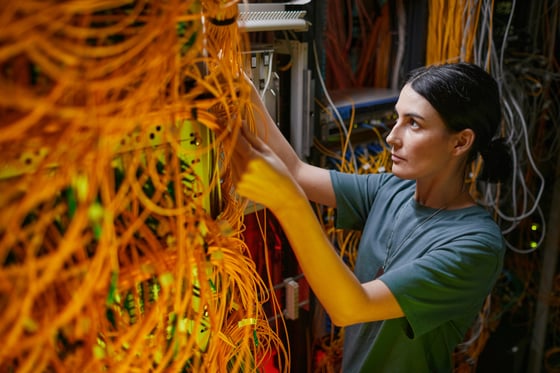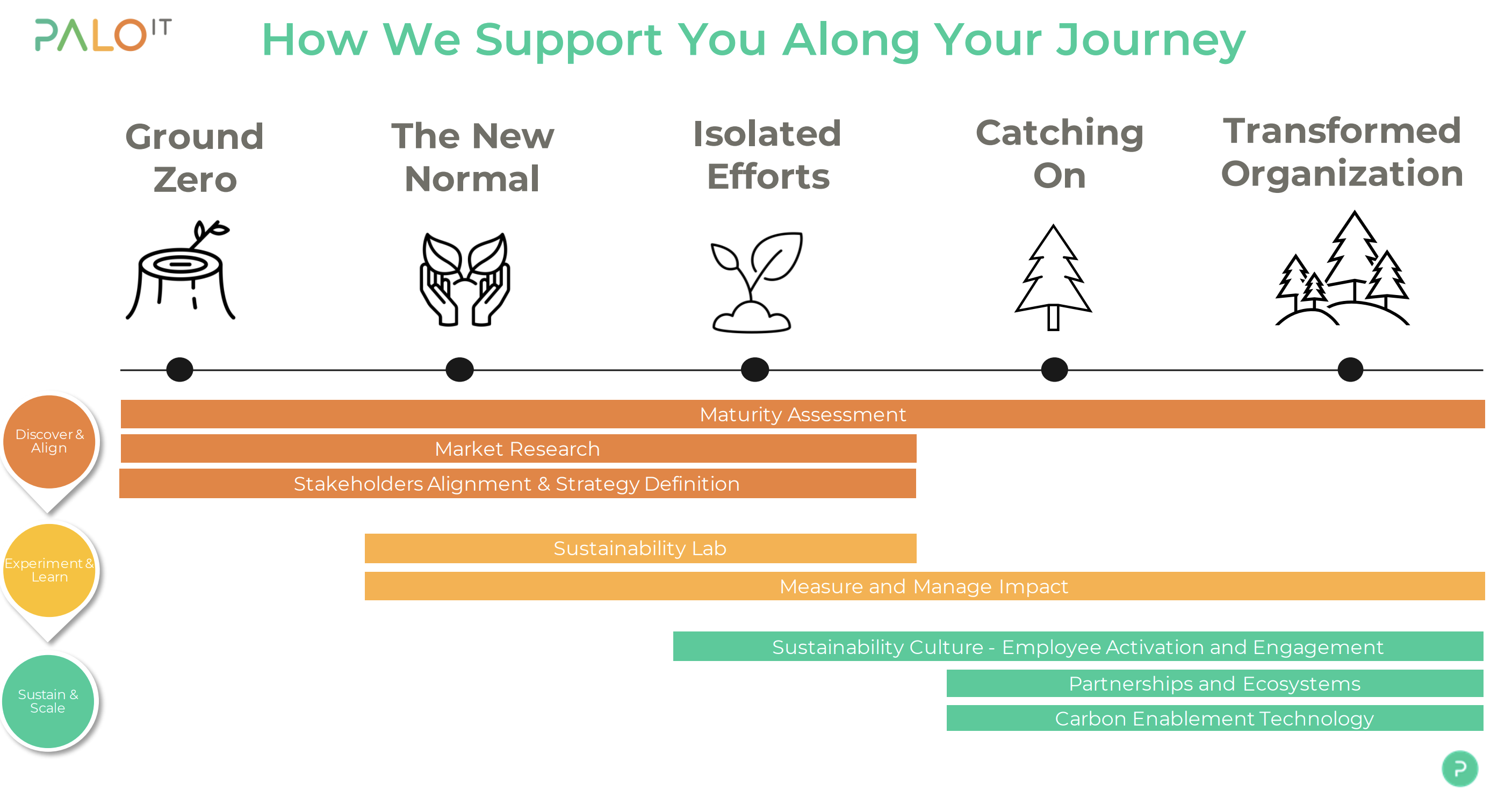In an era where environmental concerns are at the forefront of global discourse, the relationship between information technology (IT) and sustainability has become a topic of paramount importance. While some may perceive these two domains as conflicting, the reality is that they are inextricably linked, and their harmonious coexistence is crucial for driving positive change.
The Environmental Impact of IT
The rapid growth of the IT industry has undoubtedly contributed to the increasing demand for energy and resources. Data centers, which power our digital world, consume vast amounts of electricity and generate significant carbon emissions. Additionally, the production and disposal of electronic devices pose environmental challenges, contributing to e-waste and resource depletion.

This is one of many examples that can be used to villainize tech as a driving cause of environmental issues. However, it would be shortsighted to view IT solely through the lens of its environmental impact. Technology has the potential to be a powerful catalyst for sustainability, enabling innovative solutions that can mitigate environmental challenges and drive positive change.
The hunt for new smarter ways to support our development has always been a key driver of technological advancement. Today as our civilisation faces a new unprecedented challenge, technology can play a crucial role in decoupling development and environmental degradation. - Marco Lambertini, Convener, Nature Positive Initiative
IT as an Enabler of Sustainability
Technology is not the problem, if we start using it as part of the solution. “By leveraging the power of IT, we can develop innovative solutions that address environmental challenges, optimize resource utilization, and promote sustainable practices across various industries."
This era presents a unique opportunity to leverage advanced technologies and behavioural shifts to empower businesses and individuals in making sustainability-driven decisions. This era calls for solutions that are not only feasible but also ready for advancement, focusing on harnessing technology to provide actionable insights and enhance decision-making processes.
Blockchain: Revolutionizing Commodity Markets
This year, WWF in Australia, Fiji, and New Zealand joined forces to eliminate illegal fishing and forced labor within the tuna fishing industry using blockchain technology. With the slogan "From bait to plate," blockchain innovations allow consumers to trace the entire journey of their tuna—potentially extending to other agricultural commodities and marine life—revolutionizing certification and traceability systems. They are also able to utilize satellite data and cost-effective GPS tracking to visualize and understand global fishing and vessel activity.
AI: Wildlife's Protector
Although technology and nature may appear unrelated, innovations like Artificial Intelligence (AI), seemingly removed from the natural world, are essential to conservation efforts.
In China, WWF and tech leader Intel utilize AI to protect wild tigers and their habitats, thereby safeguarding numerous species and enhancing carbon storage, critical watersheds, and local communities.
We have also established PALO IT as a leader in integrating sustainability with technology, working on innovative projects that demonstrate this commitment - Crafting Tech for Good.
CIX Exchange
The CIX Exchange stands out as a pioneering initiative in Singapore, representing the first platform of its kind dedicated to the trading of carbon credits and backed by major banks and financial institutions, which underscores a strong commitment from the financial sector to support sustainable practices. By facilitating transactions between buyers and sellers of carbon credits, CIX promotes transparency and efficiency in the carbon market, enabling organizations to effectively offset their carbon footprints. The robust digital infrastructure of the exchange ensures secure transactions and real-time tracking of trades, empowering businesses to make informed decisions regarding their carbon offset strategies. As Singapore positions itself as a regional leader in sustainability, the CIX Exchange serves as a vital tool for organizations aiming to meet their environmental goals while contributing to a greener economy, exemplifying how collaboration between the tech and finance sectors can drive significant change in addressing climate challenges. Read more here.
Greenbolt Exchange
 The Green Bolt Exchange initiative is a groundbreaking project aimed at transforming energy consumption and distribution within communities. By addressing the "duck curve" problem associated with solar energy production, Green Bolt creates a local energy marketplace that facilitates the efficient sharing of surplus solar power. This platform enables communities to track energy supply and demand in real-time, optimizing energy distribution while cutting out intermediaries and reducing costs for consumers. Through smart home integration and electric vehicle charging solutions, Green Bolt empowers individuals and communities to take control of their energy resources, fostering sustainable practices and enhancing local energy management. This was presented at World City Summit & the PALO IT Lab Fest '24.
The Green Bolt Exchange initiative is a groundbreaking project aimed at transforming energy consumption and distribution within communities. By addressing the "duck curve" problem associated with solar energy production, Green Bolt creates a local energy marketplace that facilitates the efficient sharing of surplus solar power. This platform enables communities to track energy supply and demand in real-time, optimizing energy distribution while cutting out intermediaries and reducing costs for consumers. Through smart home integration and electric vehicle charging solutions, Green Bolt empowers individuals and communities to take control of their energy resources, fostering sustainable practices and enhancing local energy management. This was presented at World City Summit & the PALO IT Lab Fest '24.
KeplerIO
The KeplerIO project, a collaboration between PALO IT and Red Hat, exemplifies a significant advancement in sustainable computing through its innovative approach to energy management in cloud environments. Kepler operates as a Kubernetes-based Efficient Power Level Exporter, designed to monitor and analyze energy consumption across various containers and pods. By utilizing Prometheus metrics, Kepler provides organizations with critical insights into their energy usage, enabling them to optimize workload scheduling and configuration for enhanced energy efficiency. This not only helps businesses meet sustainability goals but also supports compliance with emerging regulations on energy consumption reporting. The project encourages a culture of accountability and innovation, providing a framework for organizations to track their energy metrics effectively.
Impact Tracker
![]() The Impact Tracker is another innovative solution from PALO IT designed to support organizations in their sustainability efforts. This comprehensive tool simplifies the orchestration of Environmental, Social, and Governance (ESG) metrics, allowing businesses to assess their performance effectively. By enabling organizations to analyze both structured and unstructured ESG data in their local formats, the Impact Tracker promotes data-driven decision-making and visualizes the broader impact of their operations. As companies face increasing pressure to comply with ESG standards, the Impact Tracker serves as an essential resource for capturing, transforming, and analyzing ESG metrics, ultimately helping organizations demonstrate their commitment to sustainable practices in today’s business landscape.
The Impact Tracker is another innovative solution from PALO IT designed to support organizations in their sustainability efforts. This comprehensive tool simplifies the orchestration of Environmental, Social, and Governance (ESG) metrics, allowing businesses to assess their performance effectively. By enabling organizations to analyze both structured and unstructured ESG data in their local formats, the Impact Tracker promotes data-driven decision-making and visualizes the broader impact of their operations. As companies face increasing pressure to comply with ESG standards, the Impact Tracker serves as an essential resource for capturing, transforming, and analyzing ESG metrics, ultimately helping organizations demonstrate their commitment to sustainable practices in today’s business landscape.
Sustainable IT Practices
While IT can drive sustainability, it is equally important for the industry itself to adopt sustainable practices. This includes implementing energy-efficient data centers, promoting the circular economy through responsible e-waste management, and developing software and hardware solutions with a focus on energy efficiency and resource conservation.
Leading technology companies are already taking steps in this direction. For instance, Google has achieved carbon neutrality for its operations and is actively pursuing renewable energy sources to power its data centres. Similarly, Apple has committed to becoming carbon neutral across its entire business and manufacturing supply chain by 2030.
Achieving a truly sustainable future requires collaboration between IT professionals, policymakers, and environmental experts. By fostering interdisciplinary partnerships and encouraging open dialogue, we can develop innovative solutions that leverage technology to address environmental challenges while minimizing the industry's ecological footprint.
Take the Next Step
As we navigate the complexities of the 21st century, it is evident that IT and sustainability are not at odds but rather complementary forces that can drive positive change. By striking the right balance and leveraging the power of technology responsibly, we can pave the way for a greener, more sustainable future, where innovation and environmental stewardship go hand in hand.

PALO IT recognizes that the intersection of technology and sustainability is not just a necessity but an opportunity for organizations to thrive. Backed by our tagline – Crafting Tech for Good, we have supported organisations from all stages of their sustainability journey.
To kickstart your sustainability journey, we offer:
- Comprehensive assessments of operational maturity that identify strengths and weaknesses
- awareness and training programs designed to educate teams on sustainable practices and the importance of integrating these principles into their daily operations.
PALO IT also positions itself as a seasoned leader in guiding organizations through the ideation phase to develop innovative solutions that align with sustainability goals:
- Proof of concept (POC) initiatives to test new ideas in a controlled environment, ensuring they are viable before full-scale implementation.
- Roll out & Scaling, ensuring they are integrated seamlessly into existing systems.
- Continuous monitoring is essential with tools and frameworks to track progress and make necessary adjustments.
By leveraging our expertise in sustainable IT, PALO IT provides organizations with a comprehensive approach to reducing their carbon footprint and optimizing operational efficiency. This holistic approach positions PALO IT as a crucial partner for businesses aiming to balance technological advancement with environmental stewardship.
If you're eager to explore how IT can drive sustainability and foster positive change, connect with our experts. Our team specializes in integrating sustainable practices within technology to help organizations reduce their environmental impact. Contact us today to schedule a consultation and discover how leveraging IT can transform your approach to sustainability and innovation.

